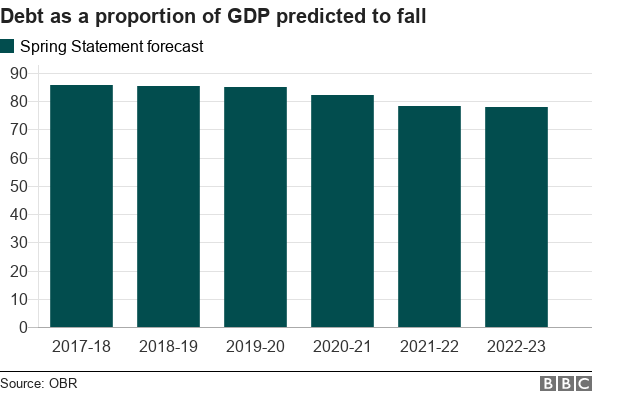Spring Statement: Is the chancellor right that debt is shrinking?
- Published

Chancellor Philip Hammond has been talking a lot about debt falling.
In his Spring Statement, he referred to the predictions from the Office for Budget Responsibility, saying "it forecasts... a shrinking debt".
He also referred to the country expecting "the first sustained fall in debt in 17 years".
But, confusingly, when he says debt is expected to fall he doesn't mean that the government will owe less money.
The figure for debt that he is using is the total amount the government owes divided by gross domestic product (GDP), which is a measure of everything produced by the country in a year.

You can see from the chart above that debt as a proportion of GDP is expected to fall for the next five years, as indeed it was at the time of the Budget in November.
Why does it make sense to talk about debt as a proportion of GDP?
Well, total debt in the UK economy is about £1.8 trillion. The national debt in the US is about $20tn, but that doesn't mean that the debt problems in the US are 10 times as severe as the UK because it has a bigger economy so can afford to be in more debt.
But debt as a proportion of GDP may be falling while the actual cash value of that debt in billions of pounds is growing.

This chart shows that the OBR is expecting total debt to rise for the next three years, then fall back for two years before growing again in 2022-23.
So although debt as a proportion of GDP is expected to fall from 85.6% of GDP this year to 77.9% in 2022-23, the actual amount of debt is expected to rise from £1,783bn to £1,893bn.
If you were really listening carefully you'll also have noticed a difference in the chancellor's wording since Sunday, when he told the BBC's Andrew Marr Show: "What we're about to see is debt starting to fall after it's been growing for 17 continuous years."
In the Spring Statement, he described it as: "The first sustained fall in debt in 17 years."
That's because there was a small fall in debt as a proportion of GDP in 2015-16.
But you do indeed have to go back to 2000-01 to find the previous fall.




- Published13 March 2018
